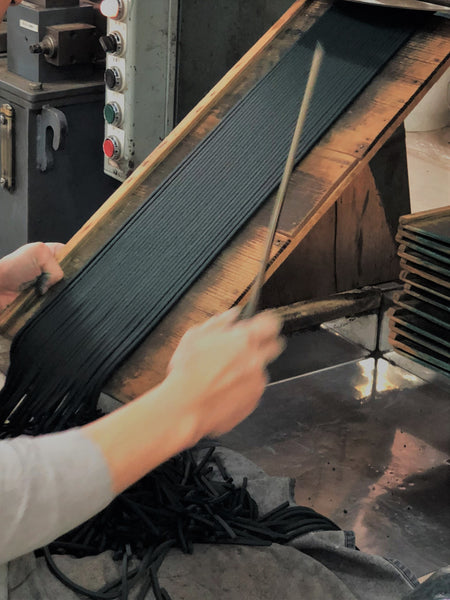- Sharpening the senses
- Purifying mind and body
- Eliminating pollutants
- Awakening the spirit
- A companion in solitude
- Calming in times of turbulence
- Never unpleasant, even in abundance
- Sufficient, even in small amounts
- Doesn't age or break down, even with time
- Does no harm
6世紀、日本の仏教の僧侶によって導入された、お香を焚くという古くからの儀式は、式典、お祈り、瞑想と共に行われてきました。 14世紀、戦国武将は戦闘で無敵になることを願い、お香を使って鎧を浄化していました。 15世紀から16世紀にかけて、日本ではお香が人気を博し、より多くの人々が日常的にお香を焚くようになりました。とても上品な文化とその香り、高品質のお香によって得られる効果をみてみましょう。
1. 感覚を研ぎ澄ます
2.心身を浄化する
3.けがれを取り除く
4.集中してリラックスができる
5.孤独感を払う
6.忙しい時を和ませる
7.多くあっても邪魔にならない
8.少なくても十分香りを放つ
9.長い間保存しても朽ちない
10.常用しても無害
At Gyokusyodou, artisans have been crafting incense since 1804 — more than two hundred years ago. Sticks are made from dried and powdered bark of the Lauraceae tree, Machilus thunbergii. Fragrant Chinese herbal medicines and essences are added to the mix, forming a thick paste of incense base which is then pressed into fine lines of raw incense.
玉初堂では、200年以上前の1804年から職人がお香を作り続けています。 お香は、クスノキ科の木、タブの木の乾燥および粉末樹皮から作られています。 香りのよい漢方薬やスパイスを加えて練られ、お香の細い線状に形成されます。



線状に押し出されたお香は、木製の形に細心の注意を払って配置され、乾燥させられます。古来では、お香は適度な温度・湿度を調節しながら自然乾燥で約4週間をかけてつくられていました。職人は製造工程のあらゆる段階に深く関わり、自然素材と対話するように、魂を込めてお香を作ってきました。



At home, we use incense as part of our daily routine. Olfactory pleasures are deeply connected to the brain especially in forming memories, so the scent of burning incense lightly wafting through the air while we practice yoga or meditation, or accompanying us when we bathe, lets us get into the right headspace of calm and stillness.
私たちは家で、日常の習慣の1つとしてお香を焚いています。 嗅覚は、特に記憶を形成する脳の部分と深く関係しているため、ヨガや瞑想をしている間、空中を軽く漂うお香を焚く香りは、頭の中の心地よい場所へと入っていきます。
 Another special way we use incense is with a smudging ceremony. Light an incense and hold the incense holder to allow the smoke to gently wash over you. Do the same to your space: Cleanse a room by lighting an incense and carrying the incense holder to the four points of the room. Start in the east where the sun rises, let the smoke drift throughout the area, then head to the north, west, and south.
Another special way we use incense is with a smudging ceremony. Light an incense and hold the incense holder to allow the smoke to gently wash over you. Do the same to your space: Cleanse a room by lighting an incense and carrying the incense holder to the four points of the room. Start in the east where the sun rises, let the smoke drift throughout the area, then head to the north, west, and south.
Take your time and allow the incense smoke to cleanse the area. Visualize that the energy in your body and space is being cleansed and anything negative is replaced with positive energy. This simple practice has been used for millennia, purifying spaces and reconnecting us to our higher selves.
お香は空間の浄化にも使うことができます。 お香に火をつけ、煙がやさしく波打つように、部屋の四方を浄化します。 太陽が昇る東から始めて、煙を空間全体に漂わせてから、北、西、南に向かいます。
時間をかけて、お香の煙がその空間を浄化するのを待ちます。 部屋のエネルギーが浄化されているか、何かネガティブなものがポジティブなエネルギーに置き換えられていることを感じてください。 この簡単な方法は、何千年もの間、空間を浄化し、自分自身を高めるために行われてきました。

